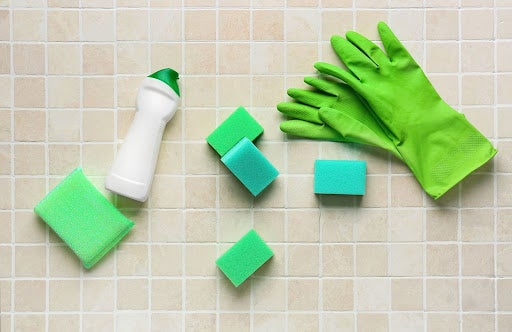When we talk about “living healthy,” most of us think about eating right and exercising regularly. But healthy doesn’t stop there.
Take your home, for instance. Is your home clean AND healthy? What about your kitchen? Germs and bacteria are mostly found in the kitchen since it is one of the most used rooms in the home. The kitchen is where food is prepared, children do their homework, and family and friends gather together, which is why the kitchen is an important place to practice good hygiene.
How do you keep your kitchen healthy AND clean? Start by going green!
Use glass containers instead of plastic ones to store and also to heat up your food. Glass containers can be used in the microwave safely, which means you don’t have to worry about chemicals coming in contact with your food.
Wash your fruits and vegetables with a spritz of vinegar and warm water. Pat them dry and store them in a cool place. Do not store clean and unwashed produce in the same place.
According to the Centers for Disease Control and Prevention (CDC), about ten million cases of food poisoning occur in the United States every year, and one out of every five outbreaks of food-borne illnesses are caused by food that people eat in their homes. Since leafy vegetables and plants are responsible for over half the cases reported, be sure to wash them thoroughly before cooking or eating them. Because one-third of the reported cases are caused by contaminated poultry, be sure to wash your poultry with a vinegar and water solution first before preparing.
Some of the more common kitchen germs are shigella, dysenteriae, E. coli and salmonella. Refrigerator ice and water dispensers, spatulas, refrigerator vegetable and meat compartments, and rubber gaskets on blenders are known to harbor these and other bacteria the most.
Since water and ice dispensers are moist areas, they have a tendency to breed organisms containing mold and yeast, something allergy sufferers could do without.
Refrigerator vegetable and meat compartments are homes to salmonella and listeria.
Mold, yeast, and E. coli lurk on spatulas. If your spatula scraper and handle can be separated, be sure to clean both pieces to get rid of the old food found on the inside of the spatula.
Blender gaskets, if not cleaned properly, can harbor salmonella, E. coli, yeast and mold. Be sure to disassemble the blenders before cleaning them or placing them in the dishwasher.
Rinse can openers with soap and warm water after using them. Dry thoroughly before putting them away.
Wipe down the inside and outside of your refrigerator and freezer. Don’t forget the corners!
Clean your microwave by placing a bowl of water and lemon wedges in the microwave. Set timer for one minute. Take out bowl and wipe the inside walls of the microwave with a damp microfiber cloth.
Clean countertops, cutting boards, light switches, cabinet hardware and floors with your favorite natural homemade ingredients. Some ingredients to try are:
Vinegar (my favorite). Vinegar is an acidic solution that kills germs and microbes. For a great sanitizer, mix 1 cup water, ½ cup apple cider or white vinegar, and a few drops of citrus essential oil in a spray bottle. Spray. Wipe clean with a microfiber cloth.
Hydrogen Peroxide (my second favorite). Combined with vinegar, hydrogen peroxide is a wonderful bacteria killer. Use hydrogen peroxide alone, with vinegar, or mix with equal parts of warm water to banish salmonella, E. coli and shigella on countertops, cutting boards, and appliances.
Tea Tree Oil. This antibiotic-resistant bacteria essential oil kills shigella, salmonella and E. coli on all surfaces. For a powerful cleaner, mix 2 cups warm water, 2 tablespoons white vinegar, 1/2 teaspoon liquid castile soap, and 15 drops of tea tree oil. Pour into spray bottle. Spray and wipe clean.
Grapefruit Seed Extract. Grapefruit seed extract is a liquid derived from the pulp, seeds, and white membranes of grapefruit. It is a potent antimicrobial and disinfectant that works against bacteria, flu and viruses which can cause ear infections, sinusitis and meningitis. For a fruit and vegetable wash, add 20 drops of the extract to a sink filled with warm water. To clean your cutting board, add 10 drops of the extract to the surface and spread it around with a damp cloth. Let sit for 30 minutes. Rinse then wipe clean. For an all-purpose cleaner, add 20 drops of extract to a spray bottle full of warm water. Mix, spray and wipe clean.
Neem Oil. Made from seeds of trees in India, Neem oil has sanitizing properties and can also be used as an insect repellent to keep insects out of the kitchen. In order for the oil to work properly, it must be combined with a vegetable-based liquid soap such as Castile Soap. Add a few drops of Neem oil, a tablespoon of Castile Soap and some warm water to a spray bottle. Shake, spray and wipe clean.
Keeping your kitchen free from germs and bacteria is a great start to a healthy family and a healthier home!



